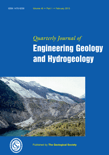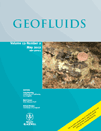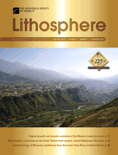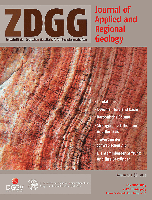
BOLETIN GEOLOGICO Y MINERO
Scope & Guideline
Fostering Innovation in Earth Sciences
Introduction
Aims and Scopes
- Geotechnical and Geophysical Studies:
The journal frequently publishes studies focused on geotechnical properties of soils and rocks, as well as geophysical methods for subsurface exploration, highlighting the importance of these techniques in mining and construction. - Hydrogeology and Groundwater Management:
A significant portion of the research addresses hydrogeological themes, including aquifer characterization, groundwater recharge, and the impact of human activities on water resources, showcasing the relevance of sustainable water management. - Environmental Impact and Recovery:
The journal includes articles related to the environmental consequences of mining activities, as well as strategies for remediation and recovery of affected areas, emphasizing the balance between resource extraction and ecological sustainability. - Paleontology and Geobiology:
Research on paleontological findings and their geological contexts is a core theme, contributing to the understanding of historical biodiversity and geological processes. - Art and Geology Interdisciplinary Studies:
Unique to this journal, there is a focus on the intersection of geology with art, examining how geological themes influence artistic expressions and cultural heritage.
Trending and Emerging
- Geothermal Resources Exploration:
There is a notable increase in research related to geothermal exploration and the integration of geophysical methods, reflecting the growing interest in renewable energy sources and sustainable resource management. - Groundwater Contamination and Management:
The journal is increasingly publishing studies on groundwater contamination, management, and the impacts of climate change on aquifers, underscoring the urgent need for sustainable water resource practices. - Interdisciplinary Approaches to Environmental Issues:
Emerging themes include interdisciplinary studies that combine geology with social sciences, art, and environmental policy, indicating a broader perspective on geological research and its societal implications. - Impact of Climate Change on Geological Processes:
Research examining the effects of climate change on geological processes and resource availability is on the rise, highlighting the relevance of geology in understanding and mitigating climate-related challenges. - Technological Innovations in Geoscience:
There is an increasing focus on the application of new technologies, such as remote sensing and advanced modeling techniques, in geological research, reflecting the trend towards data-driven and innovative approaches.
Declining or Waning
- Traditional Mining Techniques:
There seems to be a reduction in publications focused solely on traditional mining techniques and practices, as the field increasingly emphasizes sustainable and innovative methods. - Historical Geology:
Research centered on historical geology, particularly studies that do not connect to contemporary applications or environmental considerations, is becoming less frequent, indicating a shift towards more applied geoscience. - Geological Mapping without Modern Tools:
Papers that focus on geological mapping using outdated methodologies, without integration of modern geospatial technologies, are less prevalent, reflecting a move towards more advanced and precise geological investigations.
Similar Journals

Moscow University Geology Bulletin
Pioneering Research in Earth and Planetary SciencesMoscow University Geology Bulletin, published by SPRINGER INT PUBL AG, is a prominent platform for disseminating critical research in the field of Earth and Planetary Sciences. With an ISSN of 0145-8752 and an E-ISSN of 1934-8436, this journal is well-regarded for its contributions to diverse geological studies and interdisciplinary advancements that shape our understanding of the planet. The journal has established itself in the academic community, particularly noted for its ranking in the Q3 category within Earth and Planetary Sciences as of 2023. Despite its limited open-access options, the Moscow University Geology Bulletin remains an essential resource for researchers, professionals, and students through its well-curated articles and synthesis of geoscientific knowledge. With annual volumes converging from various years, including significant years like 2012 to 2024, it aims to uphold its mission of fostering scholarly dialogue and innovation in the geosciences.

GEOLOGICA BELGICA
Empowering Research in Earth and Planetary SciencesGEOLOGICA BELGICA is a distinguished open access journal dedicated to advancing the field of Earth and Planetary Sciences, published by Geologica Belgica Luxemburga Scientia & Professionis. With an ISSN of 1374-8505 and E-ISSN of 2034-1954, the journal has been a beacon of knowledge since its establishment in 1998, ensuring the broad accessibility of crucial research findings. Based in Brussels, Belgium, the journal is recognized for its impactful contributions and has achieved a commendable Q2 ranking in the Earth and Planetary Sciences category for 2023. This makes it a vital resource for researchers, professionals, and students alike, encouraging the dissemination of cutting-edge research. Spanning a diverse range of topics within its scope and converging from 2007 to 2024, GEOLOGICA BELGICA remains committed to fostering dialogue and collaboration among earth scientists globally, further enhancing its relevance and influence in this essential field of study.

JOURNAL OF THE GEOLOGICAL SOCIETY OF INDIA
Advancing geological knowledge, one study at a time.JOURNAL OF THE GEOLOGICAL SOCIETY OF INDIA, published by Springer India, serves as a pivotal platform for researchers and practitioners in the field of geology. Established in 1979, this journal has been instrumental in advancing geological research throughout India, showcasing both regional studies and cutting-edge global research. With its Category Quartile ranking of Q3 in the geology category for 2023, and a significant Scopus rank of 171 among 321 journals in Earth and Planetary Sciences, it remains a respected source of scholarly activity. The journal is dedicated to the dissemination of original research articles, reviews, and case studies that encapsulate the dynamic scope of geological science, thus contributing to the understanding of geological phenomena. Although currently not offering open access, the journal maintains a commitment to high-quality scholarship and aims to engage a diverse readership, enhancing the knowledge and practice of geology across various disciplines.

Quarterly Journal of Engineering Geology and Hydrogeology
Exploring the Intersection of Earth Sciences and Engineering.The Quarterly Journal of Engineering Geology and Hydrogeology, published by GEOLOGICAL SOC PUBL HOUSE, stands as a crucial resource in the realms of Earth and Planetary Sciences, Geology, and Geotechnical Engineering. With an ISSN of 1470-9236 and its E-ISSN 2041-4803, this esteemed journal has been committed to disseminating high-quality research from its inception in 2001 through to 2024. Although it operates under traditional subscription access, the journal remains dedicated to providing a platform for rigorous scientific discourse and knowledge exchange. In 2023, it was recognized with a Q3 category rank across multiple disciplines, reflecting its growing influence and solid standing; it ranks #105 out of 321 in Earth and Planetary Sciences: Geology, and #97 out of 229 in Geotechnical Engineering and Engineering Geology. The journal aims to bridge the gap between theoretical research and practical applications, making it an invaluable tool for researchers, professionals, and students eager to advance their knowledge in the interrelated fields of engineering geology and hydrogeology.

REVISTA MEXICANA DE CIENCIAS GEOLOGICAS
Exploring the Depths of Geosciences in Latin AmericaREVISTA MEXICANA DE CIENCIAS GEOLOGICAS, published by the CENTRO GEOCIENCIAS UNAM, is a pivotal open-access journal in the field of geology since its inception in 1975. With an ISSN of 1026-8774 and an E-ISSN of 2007-2902, this journal plays a vital role in disseminating research findings that contribute to the understanding of geological processes, resources, and environmental challenges, particularly within a Latin American context. Although currently categorized in the Q4 quartile and ranked 244 out of 321 in the Earth and Planetary Sciences category on Scopus, the journal strives to increase its impact through rigorous peer-reviewed articles that emphasize innovative geological research. As a comprehensive resource for researchers, professionals, and students alike, REVISTA MEXICANA DE CIENCIAS GEOLOGICAS seeks to foster collaboration and knowledge exchange in the geosciences while promoting accessibility to vital information in Mexico and beyond. The journal accepts submissions in both English and Spanish, catering to a diverse audience and encouraging a wider dissemination of geological research. Explore the eclectic array of studies published from 1996 to 2024, as the journal continues to elevate and enrich the field of geology.

GEOFLUIDS
Shaping the Future of Geological Fluid StudiesGEOFLUIDS, published by WILEY-HINDAWI, is an esteemed open-access journal dedicated to advancing the field of Earth and Planetary Sciences since its inception in 2001. With an ISSN of 1468-8115 and E-ISSN 1468-8123, the journal has become increasingly accessible, allowing for broader dissemination of research findings since adopting an open-access model in 2017. The journal has established itself within the academic community, achieving a Scopus rank of #86 in the domain of General Earth and Planetary Sciences, placing it in the 56th percentile, and garnering a Q3 category classification as of 2023. GEOFLUIDS serves as a platform for interdisciplinary exchange of ideas and findings—encouraging contributions that explore fluid dynamics in geological systems and their implications for natural resources and environmental management. Researchers, professionals, and students alike are invited to contribute to and engage with the latest research in this growing field, further enhancing the journal's role in shaping the future of Earth science research.

Lithosphere
Empowering Scholars to Shape the Future of Geoscience.Lithosphere, published by GEOSCIENCEWORLD, is a premier open access journal that has been at the forefront of geological research since its inception. With the ISSN 1941-8264 and the E-ISSN 1947-4253, this journal serves as a vital resource for researchers, professionals, and students interested in Earth and planetary sciences, particularly in the field of geology. Its impressive ranking of Q2 in the 2023 category indicates its vital role in disseminating high-quality, impactful research. The journal’s commitment to open access since 2018 enhances its reach, providing global accessibility to cutting-edge studies that span a diverse range of geoscientific topics, from tectonics to sedimentology. With Scopus Rank #88 out of 321 in Earth and Planetary Sciences, it offers a strong platform for scholars to share their findings and engage with the latest advancements in the discipline. As the journal continues its convergence from 2009 to 2024, Lithosphere remains a crucial publication for those striving to deepen their understanding of Earth's systems.

Geology Geophysics and Environment
Discovering New Horizons in Geology and Environmental Studies.Geology Geophysics and Environment, published by AGH University of Science & Technology Press, is a prominent, open-access journal that has been disseminating knowledge since its inception in 2012. With its ISSN 2299-8004 and E-ISSN 2353-0790, this scholarly journal serves as a vital platform for researchers, professionals, and students interested in the interdisciplinary fields of geology, geophysics, and environmental science. By providing unrestricted access to a wide array of high-quality research articles, Geology Geophysics and Environment facilitates the sharing of innovative ideas and advancements that address some of the most pressing challenges in earth sciences today. Recognized for its contributions to the field, this journal is crucial for anyone looking to stay abreast of the latest trends and discoveries in the dynamic landscapes of geology and environmental research.

GEOLOGIA CROATICA
Driving Innovation in Geological UnderstandingGEOLOGIA CROATICA is a distinguished open-access journal published by the Croatian Geological Survey, dedicated to advancing the field of Earth and planetary sciences. Since its inception in 1992, this peer-reviewed journal has become an essential resource for researchers, professionals, and students interested in various aspects of geology. With its robust impact factor and a prestigious place in Scopus rankings, ranking 127th out of 321 in Geology and 77th out of 159 in miscellaneous Earth and Planetary Sciences as of 2023, GEOLOGIA CROATICA maintains a strong international presence. It provides a platform for the dissemination of critical research findings, promoting collaboration and knowledge sharing among the global scientific community. By focusing on high-quality manuscripts that cover geological processes, hazards, and resources, this journal is pivotal for anyone looking to contribute to or expand their understanding of geological sciences. The journal's commitment to open access ensures that invaluable research is accessible to all, fostering a more informed and scientifically engaged society.

Zeitschrift der Deutschen Gesellschaft fur Geowissenschaften
Connecting Scholars: Insights into Planetary Science and EnvironmentZeitschrift der Deutschen Gesellschaft für Geowissenschaften is a prominent academic journal published by E Schweizerbart’sche Verlagsbuchhandlung, dedicated to advancing research in the field of Earth and Planetary Sciences. With its ISSN 1860-1804 and E-ISSN 1861-4094, this journal provides a platform for researchers to disseminate high-quality scientific articles and insights that contribute to our understanding of geological and environmental phenomena. Over the years, it has established itself as a reputable source within its category, holding a Q3 ranking among the Earth and Planetary Sciences (miscellaneous) journals in 2023, and achieving an impressive 85/195 rank in Scopus, placing it in the 56th percentile. The journal is published from Germany, specifically at Johannesstraße 3A, D 70176 Stuttgart, where it fosters a collaborative environment for scholars, professionals, and students alike. Although currently not an Open Access journal, it offers critical insights into various geoscience topics, making it an essential resource for those engaged in geological research and education. With its converged years stretching from 2008 to 2024, Zeitschrift der Deutschen Gesellschaft für Geowissenschaften is poised to continue its impactful role in the geosciences community.